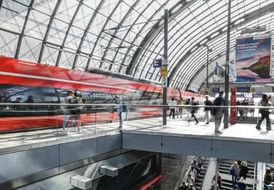Punctuality
Development in the year under review
Punctuality / % | 2022 | 2021 | 2020 |
DB Group (rail) in Germany | 90.9 | 93.7 | 95.1 |
DB rail passenger transport in Germany | 91.0 | 93.8 | 95.2 |
DB Long-Distance | 65.2 | 75.2 | 81.8 |
DB Regional | 91.8 | 94.3 | 95.6 |
DB Cargo (Germany) | 66.1 | 69.8 | 77.6 |
DB Arriva (rail: United Kingdom, Denmark, Sweden, the Netherlands, Poland and the Czech Republic) 1) | 90.2 | 93.5 | 92.3 |
DB Regional (bus) | 86.0 | 83.9 | 83.4 |
DB Cargo | 66.3 | 69.5 | 76.9 |
To measure punctuality, we compare the target arrival time to the actual arrival time for every train/bus run. We summarize the arrival of trains/buses on schedule or up to a defined maximum
delay using a punctuality rate.
1) From July 2022, excluding activities sold by DB Arriva in Sweden.
In Germany, punctuality in rail transport decreased significantly. The reasons for this development were:
- High level of primary disruptions: Particularly in the infrastructure (for example points, tracks), there was an increase in primary disruptions due to the aging and susceptibility of the facilities to faults. One of our focal points was nationwide testing and the replacement of damaged concrete ties as a result of the train accident in Garmisch-Parten-kirchen. Due to the high volume of work, slow-running points had to be set up for long periods, which had a negative impact on the operating quality.
- High level of construction activity: In 2022, there were often lots of construction activities, particularly in the highly utilized bottleneck network, while at the same time there was strained infrastructure capacity and more traffic. Extensive construction work on the Riedbahn between Mannheim and Frankfurt am Main, the most heavily burdened line in the ICE network, but also in the Hamburg hub, has led to significant additional delays.
- Highly utilized rail tracks: Around 25% of all trains run through highly overloaded rail routes, which are already very busy due to the high volume of traffic, without additional construction.
- Special external events: Weather-related events, in particular, the rapid sequence of hurricane force storms in February 2022, which in some areas caused severe damage throughout Germany, especially in northern Germany and North Rhine-Westphalia, and a number of heat-wave days between June and August. In addition, dangerous events (including suicide, a freight train collision in Leiferde) and external effects (including theft of infrastructure facilities, damage caused by vandalism and a targeted attack on the GSM-R infrastructure in the north) led to negative punctuality effects.
- 9-Euro-Ticket: Demand in regional rail passenger transport increased significantly from June to August 2022 due to the temporary introduction of the 9-Euro-Ticket. This led primarily to more excessive stopping times and train delays on tourist routes and at weekends.
- Tense personnel situation: Among other things, there were high levels of sick leave for key operational functions (for example drivers, traffic controllers, maintenance personnel) due to Covid-19 or flu, partly limited to certain areas.
- Impaired operating processes: The reduced punctuality level and low system resilience mean that personnel and vehicle rotation may no longer function, which means that maintenance allocations and train provision cannot take place as scheduled.
Significant measures for improvement
In 2022, DB Group again implemented a number of measures to improve and/or stabilize the operating quality. However, negative structural effects (high construction activity on highly utilized rail lines with old and fault-prone infrastructure) overpowered their effects. For this reason, measures are being developed and implemented that strongly intervene in the current structures and contribute to a sustainable increase in quality through paradigm shifts.
Digitalization of rail operations is central to the Strong Rail strategy. In order to ensure the completeness and suitability of activities relating to digital transformation in rail operations, the Digital Production Network (DPV) project unit was created under the Digitalization and Technology division in October 2022. DPV is thus building on the preliminary project Digital DB, among others. The aim of the work carried out by the DPV is a functioning, integrated and holistically digitalized Integrated Rail System. The DPV must ensure that functional and technical targets are harmonized and projects and measures are derived. As an initial focus, DPV aims to make significant contributions to increasing punctuality and capacity, optimizing vehicle availability
and reducing costs.
In order to effectively tackle this aim, additional funds amounting to € 135 million will be made available for digitalization measures in 2023. The project portfolio financed with these funds addresses all overarching processes. Three levels of action are touched upon in this way:
- The first-aid measures are used to remedy operational inefficiencies in the short term, for example through the automation of interfaces.
- By developing digital platforms, we are creating the conditions for an optimized digital system, for example by providing basic modules which are generally useful.
- Through the gradual further development and implementation of the “Digital DB 2035” vision, we are creating a common model for management and cooperation for business units and central functions.
In addition to the medium and long-term effects, DPV always focuses on rapid and noticeable development of effects for our customers.
In order to achieve the Federal Government’s transport policy objectives, the rail network capacity must be significantly increased. Accordingly, the Strong Rail strategy provides for the expansion of infrastructure as a central pillar. The associated extensive construction activities lead to tense capacity situations in these areas, which, in combination with the forecast strong traffic growth, can lead to negative effects on operational quality, especially in the case of the already existing bottlenecks. The aim is to achieve the growth targets with a view to expanding the infrastructure while stabilizing the operating quality at a good level.
Planning for major construction projects usually begins more than ten years before the start of construction. In order to assess the impact of construction configurations on the operating quality, reliable data on potential impairments is required. The level of detail increases as construction approaches – up to specific details about schedule planning around 20 weeks before the start of construction. As, at this time, the remaining leeway for operational and punctuality stabilizing measures is severely limited, detailed considerations for assessing the capacitive situation prevailing at the time of the final notification of planned construction measures are made 31 weeks before the start of construction. These allow the operational and qualitative risks to be identified and assessed, and countermeasures to be taken. This allows forwarding/diversion lines to be inspected or improved in terms of availability in good time, supply adjustments can be made by train operating companies and, in the case of very critical construction configurations, individual construction work can be relocated. On this basis, further quality gates follow until the actual start of construction.
As a result, the national assessment of the impact of individual construction work, which had already been produced more than two years earlier, is now once again quality-assured on three main transport corridors of the highly utilized rail network and, if necessary, substantiated in order to anticipate and reduce, in particular, the impairment of long-term rail passenger and freight transport lines. The first positive effects of this control are expected at Easter 2023, for example – a period that is usually characterized by major losses in quality (due, among other things, to construction activities).


